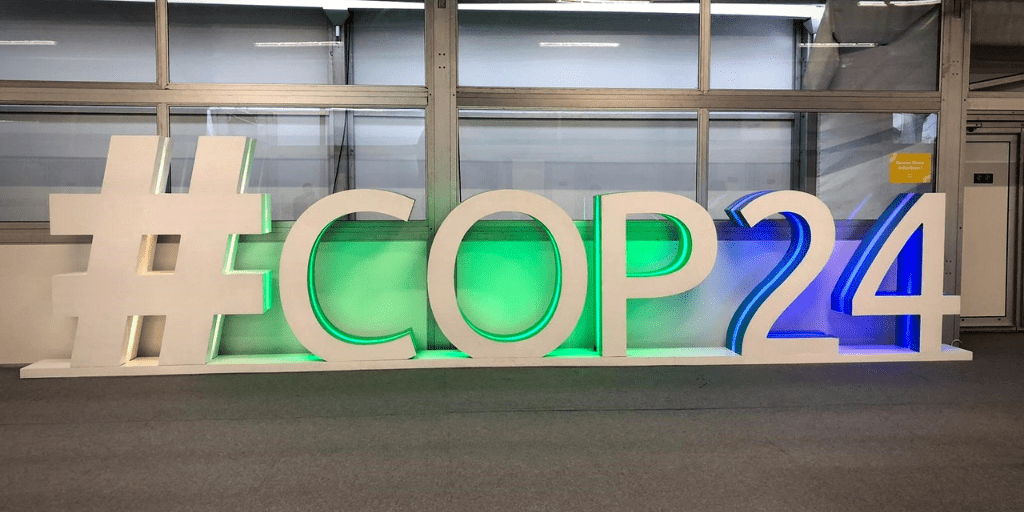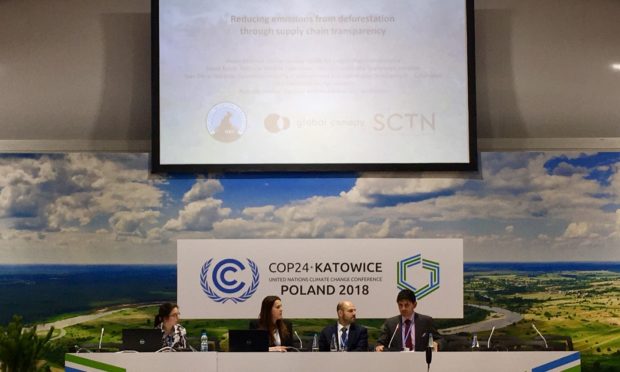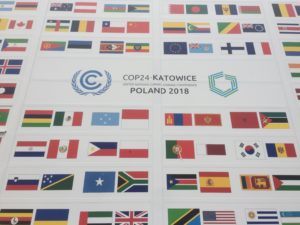We have much more to do and your continued support is needed now more than ever.
The Paris Rulebook: Will it be enough to Safeguard People and Wildlife against Climate Change?

The 24th annual Conference of the Parties to the United Nations Framework Convention on Climate Change (COP24) came to a close over the weekend, with negotiations going into overtime due to several points of contention. The United Nations Framework Convention on Climate Change (more commonly referred to as the UNFCCC), is the international treaty under which governments cooperate to combat climate change. Every year, the nearly two hundred countries which have signed the treaty (including the United States) meet at the Conference of the Parties (COP) to negotiate the global response to climate change – including the creation and continued negotiation of the Paris Agreement.
As described in our last blog, the main goal of this year’s COP was to establish a Paris ‘rulebook’ which would operationalize (i.e. provide the rules for how countries comply with) the Paris Agreement from COP21 in 2015. The Paris Agreement’s main objective is to limit global warming to well below 2 degrees Celsius, ideally no higher than 1.5 degrees Celsius (2.6° F). The recent Intergovernmental Panel on Climate Change (IPCC) report, which documented the drastic differences in warming between 1.5 and 2 degrees Celsius, raised a cloud of urgency over all aspects of this two week-long conference. Other important aspirations for the rulebook included nations raising their ambitions for greenhouse gas emission reduction pledges (“Nationally Determined Contributions” or “NDCs”) by 2020 and for wealthier countries to enhance their future climate finance commitments.

The IPCC special report became a talking point in nearly every side event and country-hosted information session. It became a point of contention, as well, in high level talks. The majority of Parties wanted to ‘welcome’ the IPCC report’s findings, but the United States, Russia, Saudi Arabia and Kuwait, blocked this language, only wanting to ‘note’ the report. This political move did little to change the negotiations moving forward, but put a spotlight on these few countries’ unwillingness to address the urgency of climate change action. Indeed, a key finding of the report is that 1.5 degrees Celsius of global warming will occur more quickly than previously thought, only giving us 12 years to halve current global emissions in order to reach this target.
After two weeks of climate talks in the small Polish city of Katowice, the foundation for a functioning Paris rulebook was created. It will provide a common set of rules on transparency and accounting of countries’ climate action progress (i.e. what kinds of emissions should be counted in the pledges or NDCs, how countries keep track, and how they let everyone else know what they’re doing). Countries also agreed to regularly take stock of collective progress on reducing emissions, to increase and align how they report on climate-related international finance with the Paris Agreement, and to address the unavoidable loss and damage associated with climate change in developing countries. Contributions were made by some countries to the Green Climate Fund, the Least Developed Countries Fund, and the Adaptation Fund – all designed to channel finance from richer developed countries to poorer developing countries to help them mitigate and adapt to climate change . Unfortunately, it is estimated that costs of climate action in developing countries is already well past $100 billion a year, making these contributions woefully inadequate.
Major gaps still remain in this year’s final decisions, including the implementation of Article 6 of the Paris Agreement – the topic of how emissions trading and a global carbon market will function. The issue of double counting (when a single emissions reduction credit is counted by both the selling country and the purchasing country) became a sticking point in the final hours of negotiations. A small group of countries, led by Brazil, would not budge on their insistence to be allowed to count emission reductions towards its own national pledge while also selling the credit to another party. This would undermine the integrity of the market mechanism, so the Parties agreed to postpone talks on this issue until next year.
Important progress was made on the Koronivia Joint Work on Agriculture (KJWA) during COP24, a UNFCCC negotiating track to consider issues related to agriculture in the context of climate change. The KJWA roadmap was created in May 2018 and laid out an agenda of workshops to advance this topic until the end of 2020. Via a previous written submission, the National Wildlife Federation had highlighted many topics for consideration in these talks, given our expertise on the impacts of agriculture and agribusiness on natural ecosystems. Our objectives are to help the KJWA roadmap consider building resiliency of farming systems and farmers, increasing production and improving livelihoods, reducing emissions of greenhouse gases and increasing sequestration. During the first week of the COP, Parties and observers, like NWF, were able to lay out how technical bodies housed within the UNFCCC (“Constituted Bodies”) can help facilitate this process (see our submission). Parties then agreed on a text that would move this process forward, though many specifics have yet to be addressed. The National Wildlife Federation will continue to push for cross-cutting concerns like improved water management, soil health, and food security in future considerations.

Despite the fact that many felt that progress in the official negotiations was not made quickly or robustly enough to set the world on the path to meeting the 1.5 degrees goal, there were many other takeaways from this year’s UN climate summit that did show promise.
The finance sector had its say midway through the climate talks. Global investors managing $32 trillion signed the Global Investor Statement which calls on world governments to achieve the goals of the Paris Agreement, to accelerate private sector investment into low carbon transitions, and to commit to improving climate related finance reporting. These investors include some of the world’s biggest pension funds, insurers, and asset managers. They called for fossil fuel subsidies to end and for substantial taxes on carbon to be introduced, claiming that without these, the world faces a financial crash substantially worse than that of the 2008 crisis. This is the largest intervention to date by investors and underscores how the private sector can drastically move these matters forward.
The fashion industry launched its Charter for Climate Action, which included over 43 leading fashion brands, retailers, supplier organizations and other stakeholders, who agreed to collectively address the climate impact of the fashion sector across its entire global supply chain. The Charter acknowledged the fashion industry’s crucial role in contributing to greenhouse gas emissions, but noted the opportunities the sector has to reduce these emissions and contribute further to sustainable development. The Charter is aligned with the goals of the Paris Agreement and sets out an industry goal to achieve net zero emissions by 2050. It also includes several steps that will be addressed by signatories in their own action plans, including using low carbon transport and sustainable materials, improved consumer awareness, and exploring “circular” business models (where waste from one company or manufacturing process becomes an input for another) to reduce waste and increase input efficiency. The Charter is open for other companies and organizations to join and has established six working groups in which signatories will define steps for implementation.

Environmental NGOs at the COP continued to concentrate on a major theme: the need to link climate action with safeguarding biodiversity. Over the course of the two weeks, side events, information sessions, and informal talks all highlighted this imperative. Many recent reports on this issue were also discussed. For example, the IPCC report notes many situations in which the difference of half a degree of warming vastly changes the projected effects on wildlife, habitat and ecosystems (coral reefs being highly susceptible to this change). Additionally, a recent study by The Nature Conservancy found that 37% of emission reductions needed by 2030 to keep global warming under 2 degrees Celsius could be achieved through nature-based solutions (for example, stopping deforestation).
The National Wildlife Federation’s side event on “How transparency can drive action on climate change commitments” explored the impacts of commodity supply chains as major drivers of tropical deforestation and climate change (two-thirds of deforestation is driven by agricultural production). NWF has presented several approaches to solving this problem at previous COPs, such as promoting ‘zero deforestation’ products and other natural climate solutions, which can enhance co-benefits that ecosystems provide, like improved water filtration, flood buffering, improved soil health, protection of habitat and wildlife, and enhanced climate resilience. This year we unveiled recent technological advancements and tools that allow companies to identify and address deforestation risks in their supply chains.
NWF explored many important new topics at the COP this year including how bioenergy is accounted for and other land use issues. In the podcast Bionic Planet, NWF’s David Burns and other climate and land-use experts explained the concept of natural climate solutions and their importance within the context of the Paris Agreement. For example, how carbon credits generated by sustainable forestry and agriculture could be recognized by international carbon markets.
As it becomes more apparent how global warming is stressing our natural world, momentum is building behind the idea that issues related to ecosystems, biodiversity and climate change must be solved together. The transition to low carbon technologies is necessary to combat climate change, but it isn’t enough to ensure a healthy world: The conservation value of intact forests and wetlands is immeasurable not just for carbon storage, but for the high levels of flora and fauna biodiversity they harbor. Cristiana Pasca-Palmer, Executive Secretary of the Secretariat of the Convention on Biological Diversity, pointed to the difficulty of linking climate change solutions with solutions to preserve biodiversity. It is clear that only by galvanizing a cohesive movement across all stakeholders – government, civil society, industry – can the political relevance of both wildlife and climate change be escalated to a top priority.
Tell your members of Congress to protect wildlife and people: urge them to work swiftly with congressional colleagues to find solutions and address a changing climate.
Take Action




















